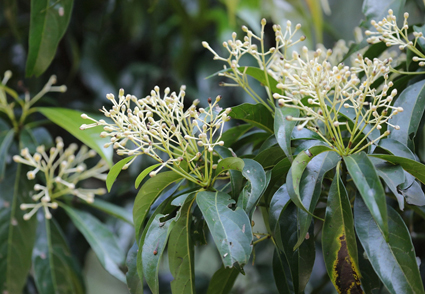Abstract
Phoebe jingxiensis, a new species of Lauraceae from China, is described and illustrated. Morphological comparison with Phoebe yaiensis, P. crassipedicella and P. lanceolata is provided. Both morphological and molecular evidence clearly indicate that P. jingxiensis is a distinct species. It differs in leaf blade being shiny and tea-colored, elliptic or elliptic-lanceolate, apex long acuminate or caudate-acuminate; inflorescences 5–12.8 cm long; fruit ovoid, 1.1–1.4 × 0.8–0.9 cm, fruiting pedicel 0.6–1.5 cm, not thickened, persistent perianth lobes subequal, 4–6 × 3.5–4 mm; and seed oval, 0.9–1.3 × 0.6–1.1 cm.
References
- APG IV (2016) An update of the Angiosperm Phylogeny Group classification for the orders and families of flowering plants: APG IV. Botanical Journal of the Linnean Society 181: 1–20. https://doi.org/10.1111/boj.12385
- Capella-Gutierrez, S., Silla-Martinez, J.M. & Gabaldon, T. (2009) trimAl: a tool for automated alignment trimming in large-scale phylogenetic analyses. Bioinformatics 25 (15): 1972–1973. https://doi.org/10.1093/bioinformatics/btp348
- Gamble, J.S. (1914) Lauraceae. In: Sargent, C.S. (Ed.) Plantae Wilsonianae: an enumeration of the woody plants collected in western China for the Arnold arboretum of Harvard University during the years 1907, 1908, and 1910 by E. H. Wilson. Publications of the Arnold Arboretum No. 4. Volume II. Part I. The University Press, Cambridge, pp. 66–86. https://doi.org/10.5962/bhl.title.191
- Hemsley, W.B. (1891) Laurineӕ. In: Forbes, F.B. & Hemsley, W.B., An enumeration of all the plants known from China proper, Formosa, Hainan, Corea, the Luchu Archipelago, and the Island of Hongkong, together with their distribution and synonymy. The Journal of the Linnean Society, Botany 26 (176): 370–393. [https://www.biodiversitylibrary.org/page/169560]
- IUCN (International Union for Conservation of Nature and Natural Resources) (2012) IUCN red list categories and criteria: version 3.1. second edition. Gland, Switzerland and Cambridge, UK, 32 pp. [https://portals.iucn.org/library/sites/library/files/documents/RL-2001-001-2nd.pdf]
- Jin, J.J., Yu, W.B., Yang, J.B., Song, Y., dePamphilis, C.W., Yi, T.S. & Li, D.Z. (2020) GetOrganelle: a fast and versatile toolkit for accurate de novo assembly of organelle genomes. Genome Biology 21: 241. https://doi.org/10.1186/s13059-020-02154-5
- Kalyaanamoorthy, S., Minh, B.Q., Wong, T.K.F., von Haeseler, A. & Jermiin, L.S. (2017) ModelFinder: fast model selection for accurate phylogenetic estimates. Nature Methods 14: 587–589. https://doi.org/10.1038/nmeth.4285
- Katoh, K. & Standley, D.M. (2013) MAFFT multiple sequence alignment software version 7: improvements in performance and usability. Molecular Biology and Evolution 30: 772–780. https://doi.org/10.1093/molbev/mst010
- Lee, S.K. (1963) Notes on Hainan lauraceous plants. Acta Phytotaxonomica Sinica 8 (3): 181–196. [https://www.jse.ac.cn/EN/Y1963/V8/I3/181]
- Merrill, E.D. (1934) A fifth supplementary list of Hainan plants. Lingnan Science Journal 13: 53–73.
- Miller, P. (1768) The gardeners dictionary, eighth edition. Published by the author, London, unnumbered. https://doi.org/10.5962/bhl.title.541
- Mo, Y.Q., Li, L., Li, J.W., Rohwer, J.G., Li, H.W. & Li, J. (2017) Alseodaphnopsis: a new genus of Lauraceae based on molecular and morphological evidence. PLoS ONE 12 (10): e0186545. https://doi.org/10.1371/journal.pone.0186545
- Nees von Esenbeck, C.G.D. (1831) Laurinӕ Indiӕ Orientalis. In: Wallich, N. (Ed.) Plantӕ Asiaticӕ rariores; or, descriptions and figures of a select number of unpublished East Indian plants. Vol. II. Treuttel and Wurtz, London, pp. 58–76. https://doi.org/10.5962/bhl.title.468
- Nees von Esenbeck, C.G.D. (1836) Systema laurinarum. Sumtibus Veitii et sociorum, Berolini, 720 pp. https://doi.org/10.5962/bhl.title.422
- Nguyen, L.T., Schmidt, H.A., von Haeseler, A. & Minh, B.Q. (2014) IQ−TREE: a fast and effective stochastic algorithm for estimating maximum−likelihood phylogenies. Molecular Biology and Evolution 32: 268–274. https://doi.org/10.1093/molbev/msu300.
- Tillich, M., Lehwark, P., Pellizzer, T., Ulbricht-Jones, E.S., Fischer, A., Bock, R. & Greiner, S. (2017) GeSeq – versatile and accurate annotation of organelle genomes. Nucleic Acids Research 45: W6−W11. https://doi.org/10.1093/nar/gkx391
- Wei, F.N. (1983) Materials of genus Phoebe Nees from China. Guihaia 3 (1): 7−10. [http://www.guihaia-journal.com/gxzwen/ch/reader/create_pdf.aspx?file_no=198301001&year_id=1983&quarter_id=1&falg=1]
- Wei, F.N. & van der Werff, H. (2008) Phoebe Nees. In: Wu, Z.Y., Raven, P.H. & Hong, D.Y. (Eds.) Flora of China, vol. 7: 189–200. Science Press, Beijing; Missouri Botanical Garden Press, St. Louis. [http://www.iplant.cn/foc/pdf/Phoebe.pdf]
- Wick, R.R., Schultz, M.B., Zobel, J. & Holt, K.E. (2015) Bandage: interactive visualization of de novo genome assemblies. Bioinformatics 31: 3350−3352. https://doi.org/10.1093/bioinformatics/btv383


